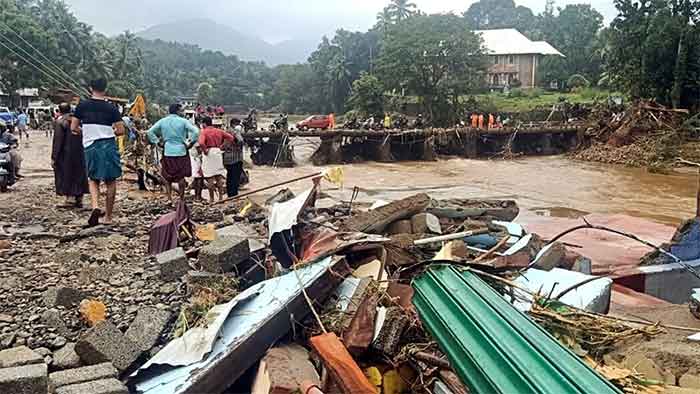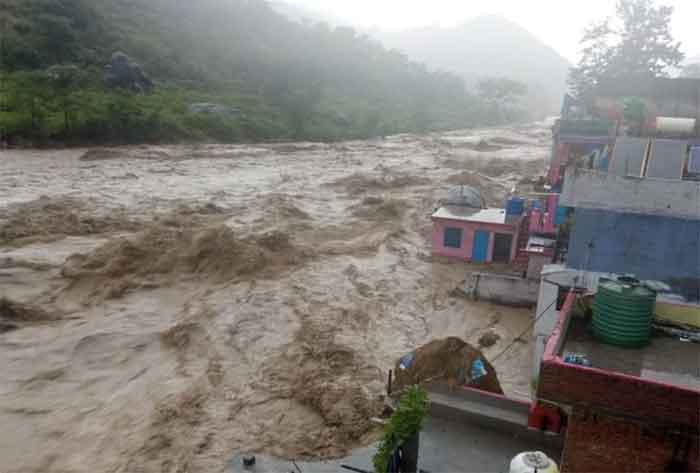
The seasonal stream rolling down along the north-western boundary of our over a century old house in the small hill town of Bhimtal, suddenly became turbulent following the continuous down pour since the early morning of October18. Our house is situated in the lowermost terrace of an orchard that surrounds it. By 10 pm it had rained enough for the stream to swell to the dimension of a roaring river loaded with boulders, trees, soil, water-pipelines and all that ever came within the range of its speedily widening flow. In the past six decades of my life I don’t remember seeing this seasonal stream in such a fury. Memories of watching, during the monsoon, the cascading flow of crystal clear water standing over a century old series of bunding- walls- constructed by my grandfather beyond an avenue of age old silver oaks -are still green to my mind. But on the night of October 18 it was different. Armed with a searchlight and umbrella, almost for the whole night, I was watching, just watching, as there was nothing else I could do -the muddy water laden with stones and all sorts of vegetation flowing over these walls; effecting their collapse one after another. The old sturdy Silver- Oaks were holding fast that very area they had grown on. A few avocados planted by me 10-12 years ago, now grown tall enough to pop above the wallowing waters, were struggling hard to stay and those just 5-6 years old had all been flushed away. Sleep we did not for the whole night, actually none in the vicinity could sleep on that fateful night.
As the dawn cracked we could see that much of the vertical slope on the other side had literally been sliced by the roaring stream. The pathway meandering uphill with a motorable tailend was nowhere to be seen and the house of a new-settler, adjacent to the motorable stretch, had its foundation exposed to the very root. Luckily the structure with its main approach all gone, was still standing erect. Our Kiwi Vineyard and the patch of plums and lime above it, was looking more like a moraine in the mallow morning light. Thank god, we all were safe, no life was lost in the small locality we live in.
Torrential rains in the second half of October, when the sun otherwise happend to be very bright in azure skies, of course is an aberration caused by climate-change, a fall out of our consumer culture. Yet, quite a few apparent and immediate reasons have also been there. Just half a kilometre vertically upward on the very face of the mountain- at the foot of which a centuries-old cluster of houses is there (of which we are also a part) -a road is being cut. The excavation is being done with JCVs keeping all rules and norms at an arm’s length. Who is making this road, why is it being made, who are the beneficiaries and to where will it lead -nobody knows. A few upcoming henchman of the ruling party are reported to have managed the allocation of government funds for cutting this road following the bulk purchase of lands from poor villages at dirt cheap rates. With tremendous value attachment, because of the construction of the road, these referred lands, located as they are at commanding points, are all set to be sold to the new settlers at lucrative price.
There is no point opposing the construction of road because these have been the harbingers of development. However cutting a road -better say bulldozing the mountains, without any survey, without any proper layout and alignment, without assessing its impact on close-by human habitations (if not on flora and fauna), that too in a complacent manner managing the official machinery and the local populace using all fair and foul -is bound to let loose a train of terrible destruction. Interestingly, the mountain that is being bulldozed has a number of aquifers and subterranean water channels. Old gazatters and writings from colonial era speak at length about it. The base of this very mountain, where the human habitations is, is full of freshwater springs. It is unfortunate that for ensuring the immediate gains of a handful of people the bounties of nature -which over the generation have been constituting the mainstay of a small human habitation -are being sidelined.
The stage is all set now for the contractors to break the huge boulders offloaded by the flash floods to portable size for carrying them away to the new construction sites. Some of it will be used as an eyewash in erecting walls, check-dams cobbled pathway etc. for the surface runoff. Funds reserved for managing the alleged natural disaster will be exhausted before the budget. These walls and the cobbled bed, as always happens, will be swept away in the next monsoon. A cover-up will be done in the name of natural calamity again and this vicious circle will keep on continuing.
This microcosm from a lessor known small mountainous region I live in, does indeed represent the macrocosm where humanity wearing a macabre face in general is ravaging the nature incessantly. From Stockholm to Rio, in all decinnial summits we do have tall claims and concerns, or call it what you will, to save the planet. These allegedly small incidents in relatively nondescript places however, do have a prognostic importance in reminding us that a pinch of deadly poison renders a seemingly sumptuous dish to an utter waste. Caring for the small issues lets the bigger ones fall at the right places -unfortunately we haven’t learnt it yet.
Rajshekhar Pant is a resident of the Kumaon hills of Uttarakhand












































